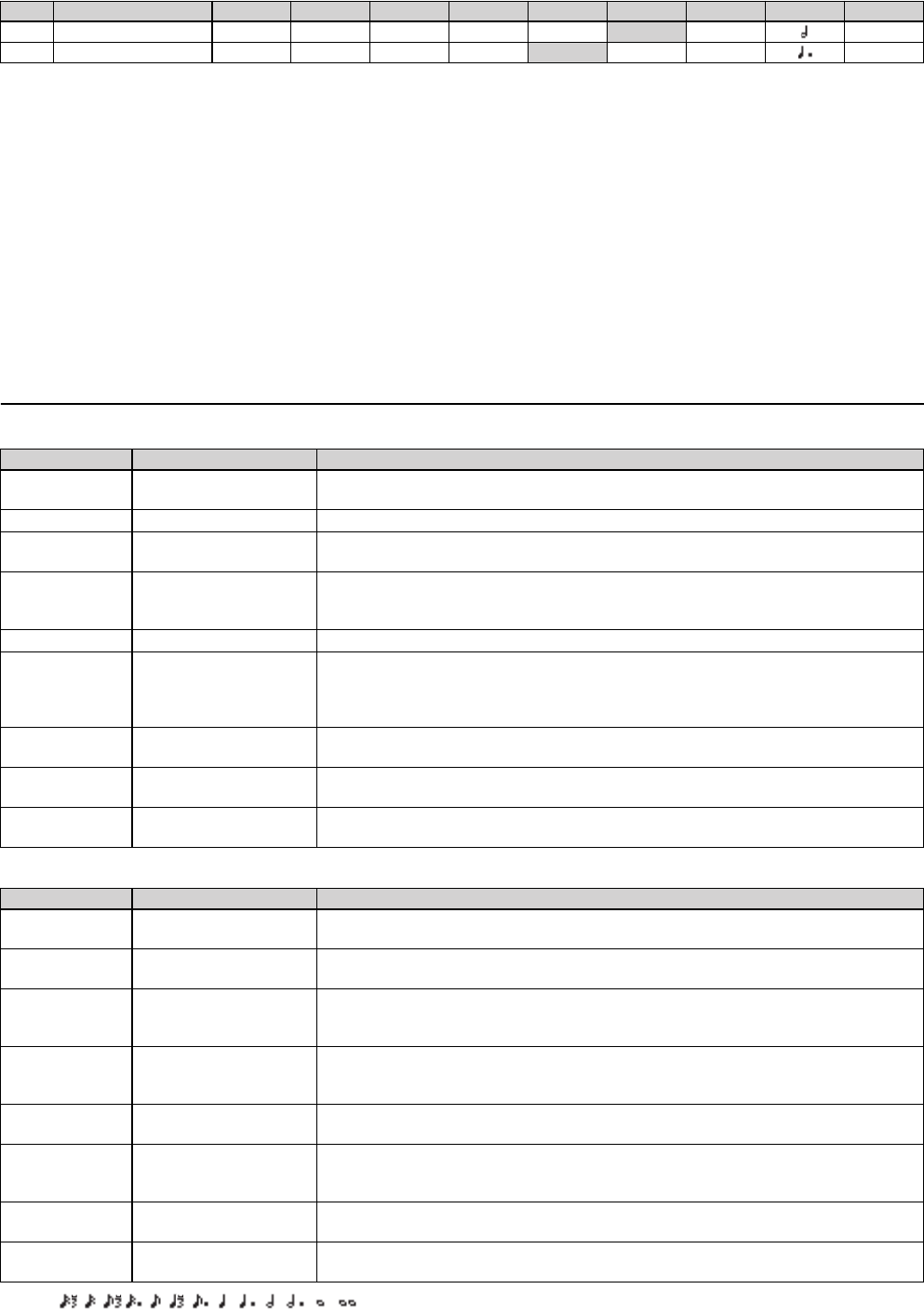
72 SPX2000—Owner’s Manual
■Fine parameters
Reverb → Pan (PRESET bank)
This applies reverb to the original sound and then applies panning.
Each aspect of the sound is controlled by the following effect parameters.
Reverb: REV TIME, HI.RATIO, INI.DLY, DIFF., DENSITY
Pan: FREQ., DEPTH, WAVE, DIR.
Balance of reverb and pan: REV.BAL
Filter/equalizer: HPF, LPF
Tempo synchronization: SYNC, NOTE, TEMPO
Output level: OUT LVL, MIX BAL.
Parameter details
■Basic parameters
■Fine parameters
No. Effect name MIX BAL. OUT LVL HPF LPF REV/SYM REV.BAL SYNC NOTE TEMPO
62 REV+SYMPHONIC 100% 100% Thru Thru 78%
OFF —
88 REV->SYMPHONIC 100% 100% Thru Thru 45% OFF —
Parameter name Range Explanation
FREQ. 0.05—40.00 Hz
Speed of modulation (panning movement). Increasing this value will make the modulation repeat
at a shorter interval.
DEPTH 0—100%
Modulation depth. Increasing this value will produce deeper modulation.
WAVE Sine, Tri, Square
Waveform of the modulation signal. This affects the character of the modulation.
You can select Sine (sine wave), Tri (triangle wave), or Square (square wave).
DIR.
L<->R, L-->R, L<--R,
Tur n L, Turn R
Direction of panning movement. L<->R makes the sound move alternately between the L and R
channels. L-->R makes the sound move from L to R and then jump back to L; L<--R does the
opposite. Turn L or Turn R makes the sound rotate toward the left or right.
REV TIME 0.3—99.0 s
Reverb time. This is expressed as the time over which reverberation at 1 kHz will decay by 60 dB.
HI.RATIO 0.1—1.0
Reverb time for the high-frequency range, expressed as a proportion of REV TIME. If this value is
0.1 the time will be 1/10th the REV TIME; if it is 1.0 the time will be the same as the REV TIME.
You can adjust these values to simulate the absorptiveness of the walls or ceiling. HI.RATIO is the
decay of the high-frequency range.
INI.DLY 0.0—500.0 ms
Delay of the early reflections relative to the original sound. This also affects the delay until the
reverberation is heard.
DIFF. 0—10
Diffusion of the sound to left and right. Increasing this value will make the reverberation more
spaciousness.
DENSITY 0—100%
Density of the reverberation. Increasing this value will make the reverberation smoother. You can
create unique effects by lowering this value.
Parameter name Range Explanation
MIX BAL. 0—100%
Balance between the original sound and effect sound. At a setting of 0% only the original sound
will be output; at a setting of 100% only the effect sound will be output.
OUT LVL 0—100%
Output level after the original sound and effect sound have been mixed.
Decrease this value if you want to lower the output. At a setting of 0% there will be no output.
HPF Thru, 21.2 Hz—8.00 kHz
A filter that cuts the low-frequency portion of the effect. Frequency components lower than the
frequency specified here will be cut. With a setting of Thru this filter will do nothing. This filter
does not affect the original sound.
LPF 50.0 Hz—16.0 kHz, Thru
A filter that cuts the high-frequency portion of the effect. Frequency components above the fre-
quency specified here will be cut. With a setting of Thru this filter will do nothing. This filter does
not affect the original sound.
REV.BAL 0—100%
Amount of auto pan. Raising this value will strengthen the auto pan effect. At a setting of 0% only
reverb will be heard.
SYNC ON, OFF
Switches tempo synchronization on/off. If this is ON, the speed of modulation will synchronize to
the tempo synchronization source specified by “TEMPO SOURCE” (page 23). The NOTE value
will be set to the synchronized tempo value.
NOTE
*a
*a.
This parameter is used for tempo synchronization. If SYNC is ON, the FREQ. value will be set
according to this value and TEMPO. If SYNC is OFF, this value is ignored.
TEMPO 25—300
This parameter is used for tempo synchronization. If SYNC is ON, the FREQ. value will be set
according to this value and NOTE. If SYNC is OFF, this value is ignored.


















